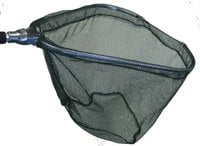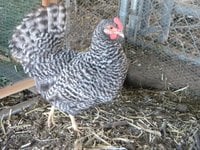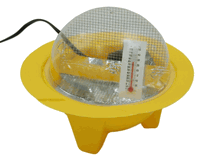While I try to always handle my birds with utmost care and kindness, preferring to navigate them by the feed bucket, a light hand, and a sweet "chook chook," there are times you simply need to get a wayward bird out of trouble or out of an area. If they are not listening to the feed bucket and resisting being picked up, then you must resort to catching them. Since my birds are comfortable in my presence (but not always at being picked up), instinct prompts one to "sneak up" on them, slowly bend, and catch...but you are almost always a split second too slow which results in an upset bird. If you do catch with that method, you are at great risk for back injury.
I actually got the KUFA telescope landing net on advice from my chiropractor. He told me he was tired of putting me back together after I had yet again pulled my stiff lumbar muscles chasing a wayward chicken. It turns out the bend, twist, catch with immediate snapped applied tension (when the bird tries to escape) is probably the worse thing you can do to your (aging) lumbar spine. He told me to do something different to chase down chickens or risk blowing a disc. Okay. He got my attention.
After examining the options on BYC and then browsing Amazon, I settled on this net to try since several Amazon reviewers said it was good with chickens. They were spot on.
This net is superlative for catching chickens. It is wide enough and large enough that the bird can easily run into it, deep enough to trap it there, and soft enough to not injure it as this particular net has a soft ring in the front leading edge (where the bird is most likely to run as it tries to escape). The net itself is sturdy yet very flexible and soft.
Its telescoping handle is easy to extend or shorten which makes it very valuable for a longer catch or tighter quarters. The overall net is very light weight, which makes it very easy to maneuver quickly. The size is large enough for the largest heavy fowl, even small turkey. Yet, I've used it with smaller pullets and even young chicks with deftness.
The only time it was a bit cumbersome was trying to corner a little one inside a smaller coop...the length of the handle and net were too bulky for really tight quarters (like a nest box corner). For that, it is best to find a salad colander or other such device.
I am amazed at how little energy I expend with this KUFA net. The birds settle very quickly once you've lowered the net on them and they realize they can't escape, keeping the bird much calmer in the process that an all out chase assault.
And my back? At around $20 (Amazon price), this net has already paid for itself with its first use as one chiropractor visit is a lot more than $20 in my area.
I highly, highly, recommend this net to catch poultry when you absolutely need to round up a bird who does not want to be picked up (but prefers to flirt with you and the feed bucket...at just that arm's length away).
Lady of McCamley
I actually got the KUFA telescope landing net on advice from my chiropractor. He told me he was tired of putting me back together after I had yet again pulled my stiff lumbar muscles chasing a wayward chicken. It turns out the bend, twist, catch with immediate snapped applied tension (when the bird tries to escape) is probably the worse thing you can do to your (aging) lumbar spine. He told me to do something different to chase down chickens or risk blowing a disc. Okay. He got my attention.
After examining the options on BYC and then browsing Amazon, I settled on this net to try since several Amazon reviewers said it was good with chickens. They were spot on.
This net is superlative for catching chickens. It is wide enough and large enough that the bird can easily run into it, deep enough to trap it there, and soft enough to not injure it as this particular net has a soft ring in the front leading edge (where the bird is most likely to run as it tries to escape). The net itself is sturdy yet very flexible and soft.
Its telescoping handle is easy to extend or shorten which makes it very valuable for a longer catch or tighter quarters. The overall net is very light weight, which makes it very easy to maneuver quickly. The size is large enough for the largest heavy fowl, even small turkey. Yet, I've used it with smaller pullets and even young chicks with deftness.
The only time it was a bit cumbersome was trying to corner a little one inside a smaller coop...the length of the handle and net were too bulky for really tight quarters (like a nest box corner). For that, it is best to find a salad colander or other such device.
I am amazed at how little energy I expend with this KUFA net. The birds settle very quickly once you've lowered the net on them and they realize they can't escape, keeping the bird much calmer in the process that an all out chase assault.
And my back? At around $20 (Amazon price), this net has already paid for itself with its first use as one chiropractor visit is a lot more than $20 in my area.
I highly, highly, recommend this net to catch poultry when you absolutely need to round up a bird who does not want to be picked up (but prefers to flirt with you and the feed bucket...at just that arm's length away).
Lady of McCamley



